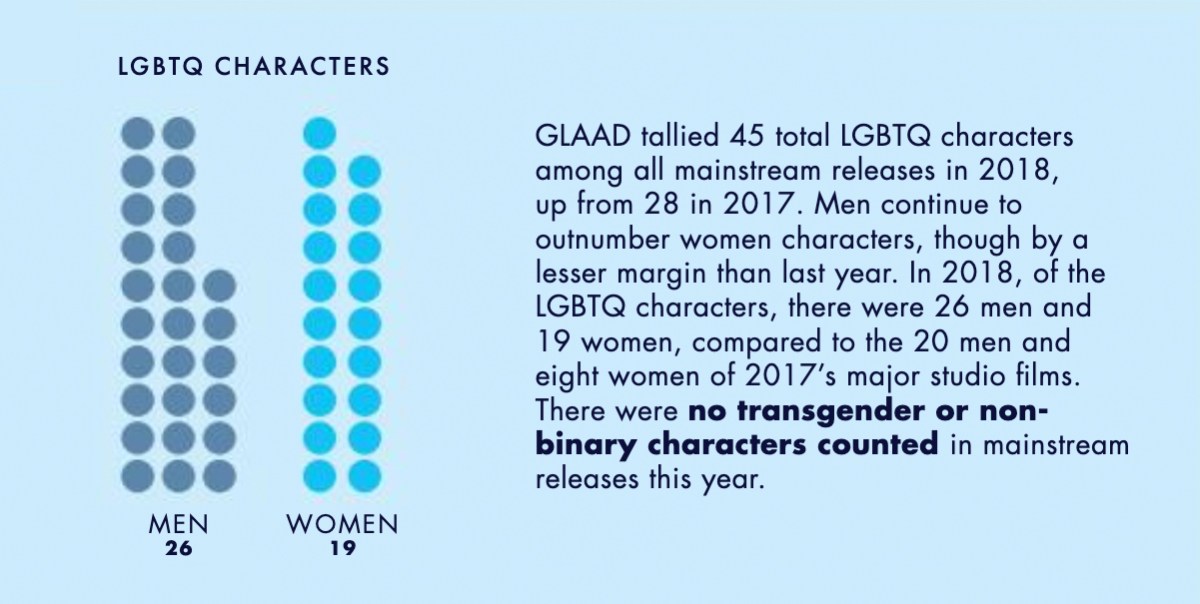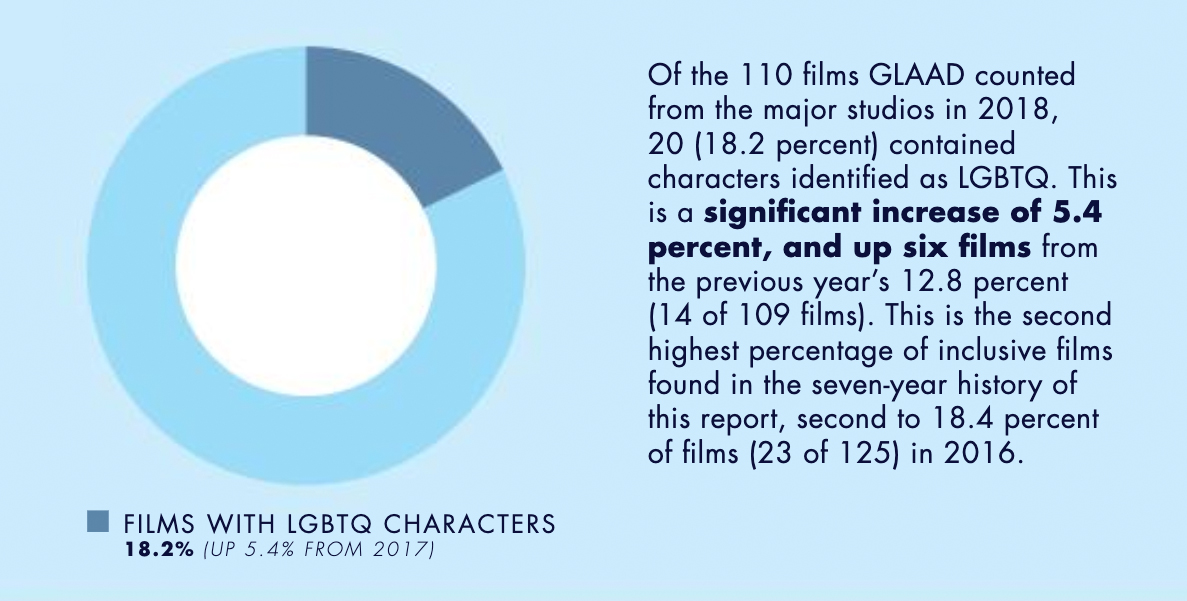It says a lot about the state of lesbian and bisexual women in film, in general, that I remembered 2019 as a pretty decent year because I saw one (1) entire gay woman in a movie where she was: a) such a main character that she had half the dialogue and was even on the movie poster, b) so gay that no one could leave the theater without knowing she was gay, and c) the theater was stadium-style in the suburbs and full of people, not an arthouse cinema in Greenwich Village with two other lesbians and one retired straight couple with a season pass to IFC.
But of course Booksmart is only one movie and — according to GLAAD’s annual Studio Responsibility Index, which dropped this morning — major studios released 118 movies in 2019. Get ready for some even more dismal numbers: Of those 118 movies, 15 included gay men, eight included lesbians, three included bisexual characters, and zero included trans characters. Also only 34% of those characters were people of color (a downtrend from 2018’s downtrend). But wait, it gets worse! There were 50 total LGB characters in major studio films, and 28 of those 50 characters received less than three minutes of speaking time and 21 of them were on-screen for less than a minute. GLAAD’s description of the two animated family films that included gay characters is almost too sad to look at: “Two dads dropping their child off to camp in Paramount’s Wonder Park, and two moms escorting their child to school in Disney’s Toy Story 4.” Blink (or be straight) and you miss it!
The write-up for Charlie’s Angels was also particularly depressing: “Charlie’s Angels features out actress Kristen Stewart as Sabina, one of the spies and a lesbian. In a mid-film scene, Sabina is distracted from her case when she stops to check out an attractive woman at the gym. Though the moment is technically enough to confirm Sabina’s interest in women.”
GLAAD’s SRI focused on the eight studios that had the highest theatrical grosses in 2019, and ranked them on a scale of “failing” to “insufficient” to “poor.” The next step up is “good,” but no studio received that rating for 2019.
I was unsurprised looking at these numbers. GLAAD’s Studio Responsibility Index is always bleak, which is one of the reasons why it’s so essential. But I was surprised by how many of these movies I knew a lot about because they included gay characters, even if only briefly — which is something GLAAD goes to great lengths to note every year. Megan Townsend, GLAAD’s Director of Entertainment Research & Analysis, consistently hammers home: “Telling meaningful LGBTQ stories is not just the right thing to do, it’s also just smart business. LGBTQ people are a significant audience who are supporting LGBTQ-inclusive films with our dollars and digital attention. Nielsen found LGBTQ audiences are more likely to see a new theatrical release more than once compared to straight audiences, and continue to stay engaged consumers, with higher levels of purchasing a digital copy, subscription service, and spreading the word online.”
At Autostraddle we know that’s true because when we write about a movie with actual LGBTQ+ women, everyone reads and shares it on social media and then comes back to comment with their own opinions after they’ve watched it (usually more than once). We will subscribe to any platform to watch a queer movie, drive for hours to see it in theaters; heck, we will even buy physical DVDs, which Drew Gregory wrote about beautifully this week in her piece about Criterion releasing Portrait Of A Lady on Fire, which was huge deal, but also out of 1,051 titles in Criterion’s collection, only 18 feature queer women.
“This isn’t theoretical. This isn’t a customer complaint,” Drew wrote. “This is about who I am. This is about who we all are. This is about what we deserve. Those of us who have long been ignored deserve to be included — no, centered — in film culture. So let’s celebrate the release of Portrait of a Lady on Fire. And then let’s ask for more. And more and more and more.”
GLAAD agrees: “Hollywood must feel encouraged and empowered to leverage that interest and buying power by delivering movies that include substantial LGBTQ characters and by unambiguously marketing and promoting these movies.”
You can read GLAAD’s full Studio Responsibility Index here.



Where’s the gay sequal/reboot trend? Desert Hearts 2, DEBs:Undercover, Booksmart:Abroad?
I am mostly over reboots and sequels but I’d be here for that!
Also, while we certainly need more original queer stories, I’d love some quality gay adaptations / reboots of straight movies – I’d watch the shit out of, like, a lesbian Princess Bride.
OMG yes. Lesbian Princess Bride all day:)
Got into an argument with a relative some years ago about representation, he said that because “gay people” are only a few percent of the population, they should only appear in a few percent of movies and TV series. Arguing with that proved fruitless. He didn’t believe in the existence of LGBTQIA+ identities other than L or G, seemed baffled by the concept of a cast being anything other than all hetero or all non-hetero, and also baffled by the idea that straight people might watch entertainment with non-straight characters. I don’t think he believed anything I said.
There’s far more than just that, but it should hint why we don’t speak to each other anymore.
“Of those 118 movies, 15 included gay men, eight included lesbian or bisexual women, and zero included trans characters.”
I looked at the overview of findings on the Glaad site, and it states “Gay men appear in 68 percent (15) of inclusive films…Lesbian representation has decreased significantly, down to 36 percent (8) of inclusive films…Bisexual representation slightly decreased to 14 percent, a one-percentage point drop but an equal number of films (three). There were zero films with transgender characters from the major studios in 2019, a disappointing finding consistent with the last two years.”
As someone who has felt the lack of bisexual representation deeply throughout my life, I’m wondering why that number (only 3 movies w/ bisexual representation) was not included and instead bi women were lumped in with lesbian women? I recognize that determining whether a character is lesbian vs bi+ when said character is a split second sidenote is fairly impossible (and that doing that kind of determination may not be productive anyways), but I do think it’s important to bring to light the specific lack of visible folks shown to be attracted to multiple genders.
Thank you so much for this comment, HP. I completely agree with you. The way I read the report, I actually thought lesbian and bisexual women characters were grouped together. Of course, all the numbers were blurring together for me by the end of it; it’s extensive! I’ll make this change so it accurately reflects that data and I do apologize for misreading it.
Meanwhile, both mainstream films and GLAAD fully ignore the existence of ace women.
GLAAD actually did note this year that for Hollywood to accurately portray the myriad intersections of the community, that films need: “More LGBTQ people of color, characters with disabilities, transgender and non-binary characters, those of different religions and faiths, body types, more queer women, characters who are asexual, and others will only fuel Hollywood’s future success.” I was really happy to see that, and hope it will become more prominent!